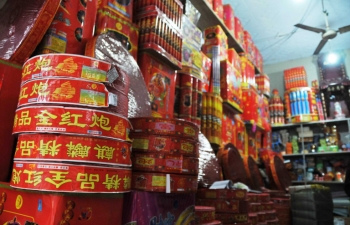Minister advises fewer firecrackers to reduce smog
 0 Comment(s)
0 Comment(s) Print
Print E-mail Xinhua, January 31, 2013
E-mail Xinhua, January 31, 2013
The Chinese public have been advised to set off fewer firecrackers or none at all during the Spring Festival to help prevent smog, the country's Environment Minister Zhou Shengxian said Thursday.
 |
|
A firecracer store. [File photo] |
Using firecrackers is a traditional practice to celebrate the Spring Festival, China's Lunar New Year. This year's festival falls on Feb. 10.
The Ministry of Environmental Protection (MEP) announced on Thursday that smog blanketing large swaths of China was thinning out, with air pollution in some cities easing.
According to monitoring as of 10 a.m. Thursday, smog-hit regions had seen lower readings of PM 2.5, or airborne particles measuring less than 2.5 micrometers in diameter.
However, cities like Jinan and Xi'an were still rated as "gravely polluted."
Other cities including Beijing, Shijiazhuang, Tianjin, Zhengzhou, Changsha, Chengdu, Shenyang, Changchun and Harbin were rated one level lower, as "seriously polluted."
Major pollutant, PM 2.5, had reduced in Beijing, with the average concentration lowering to 213 micrograms per cubic meter within 24 hours ending at 10 a.m. Thursday, from 310 micrograms per cubic meter the previous day.
The meteorological authorities forecast that the smog would gradually disperse due to rain and snow in central and eastern regions from Thursday through Saturday.
Chai Fahe, Chinese Research Academy of Environmental Sciences vice president, said the country was for the first time hit by smog of such magnitude, spanning from the north all the way to the Yangtze River Delta and the Pearl River Delta."
Hu Min, a Peking University environment science professor, said the burning of coal and biofuel, and vehicle emissions all contributed to the smog.





